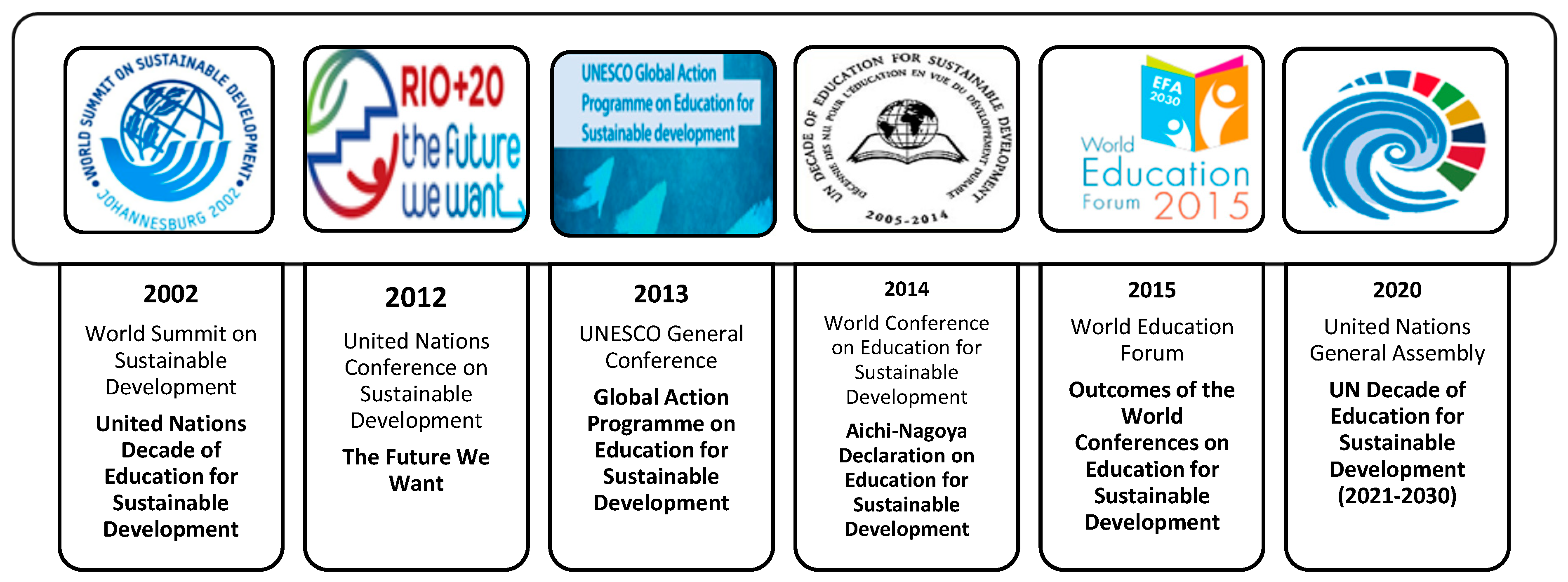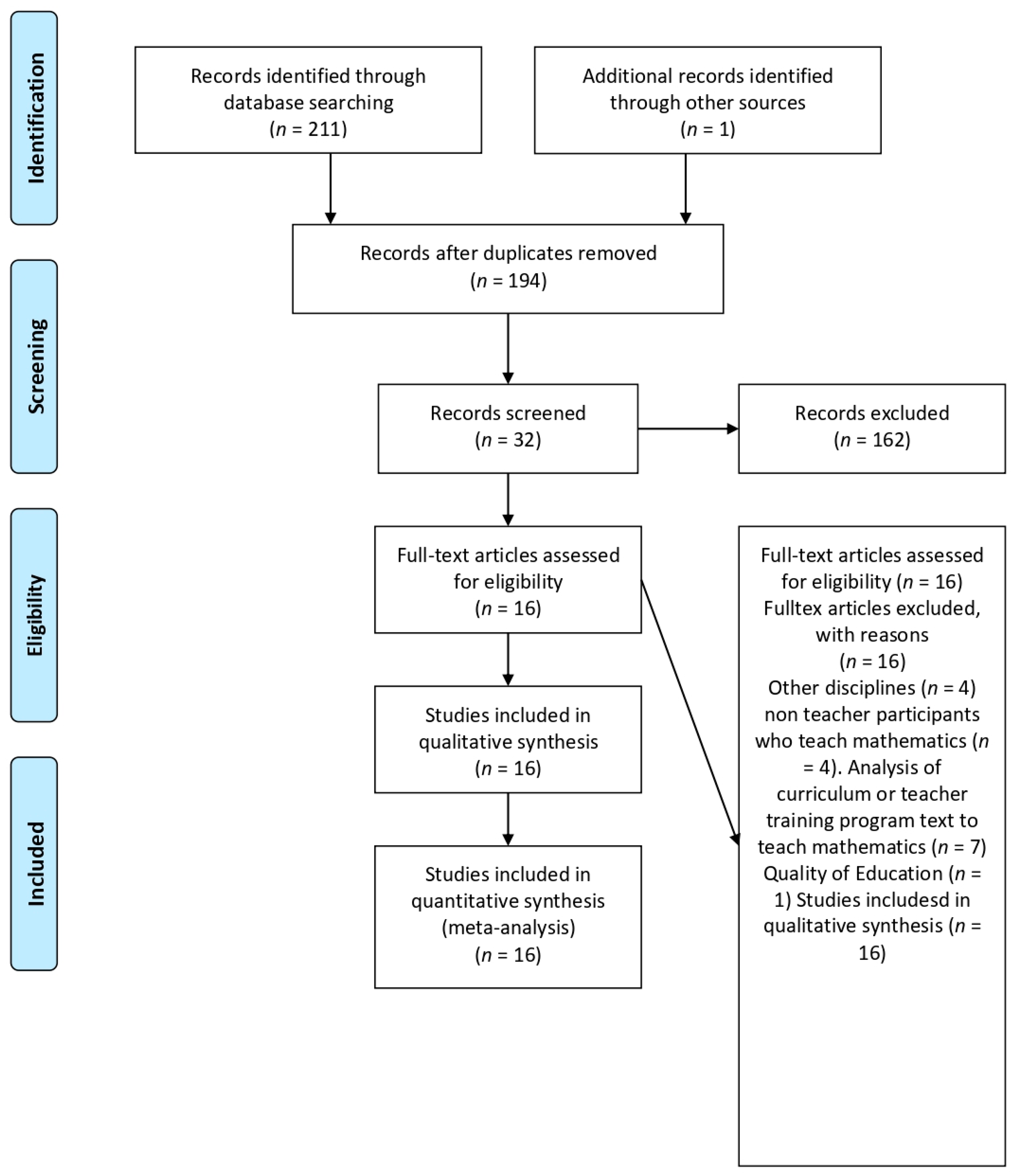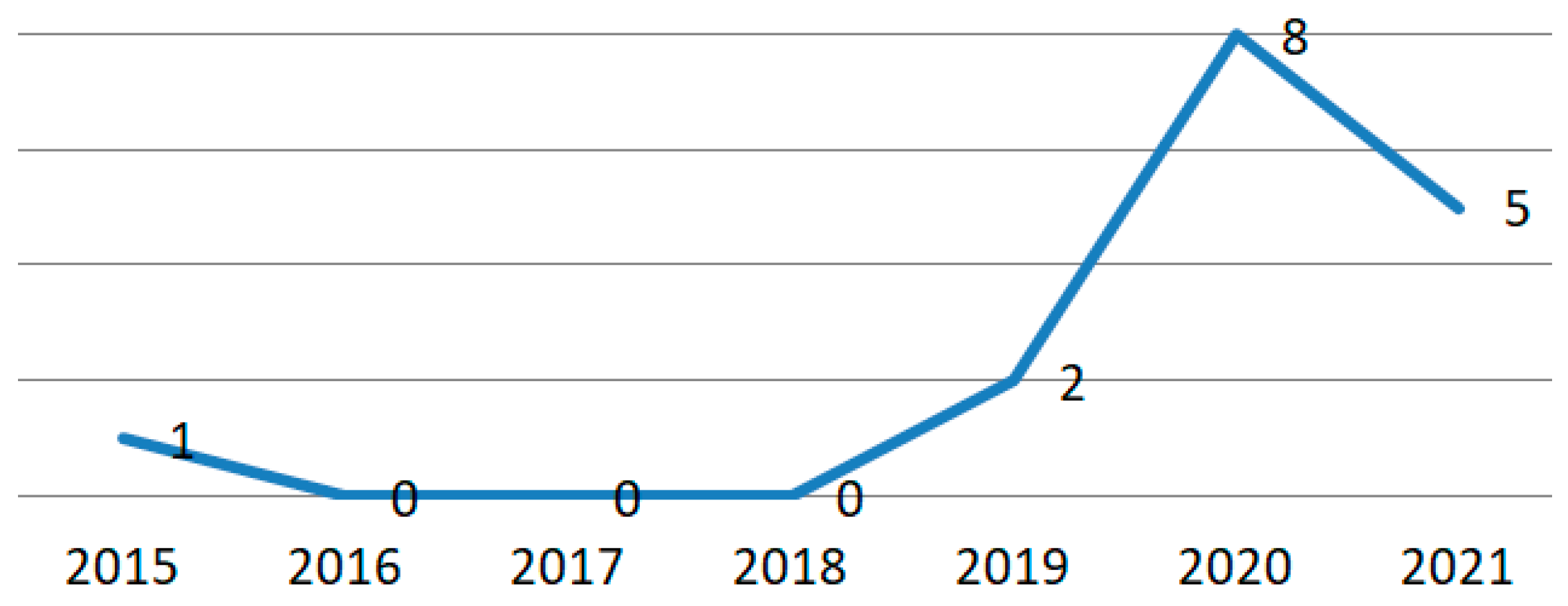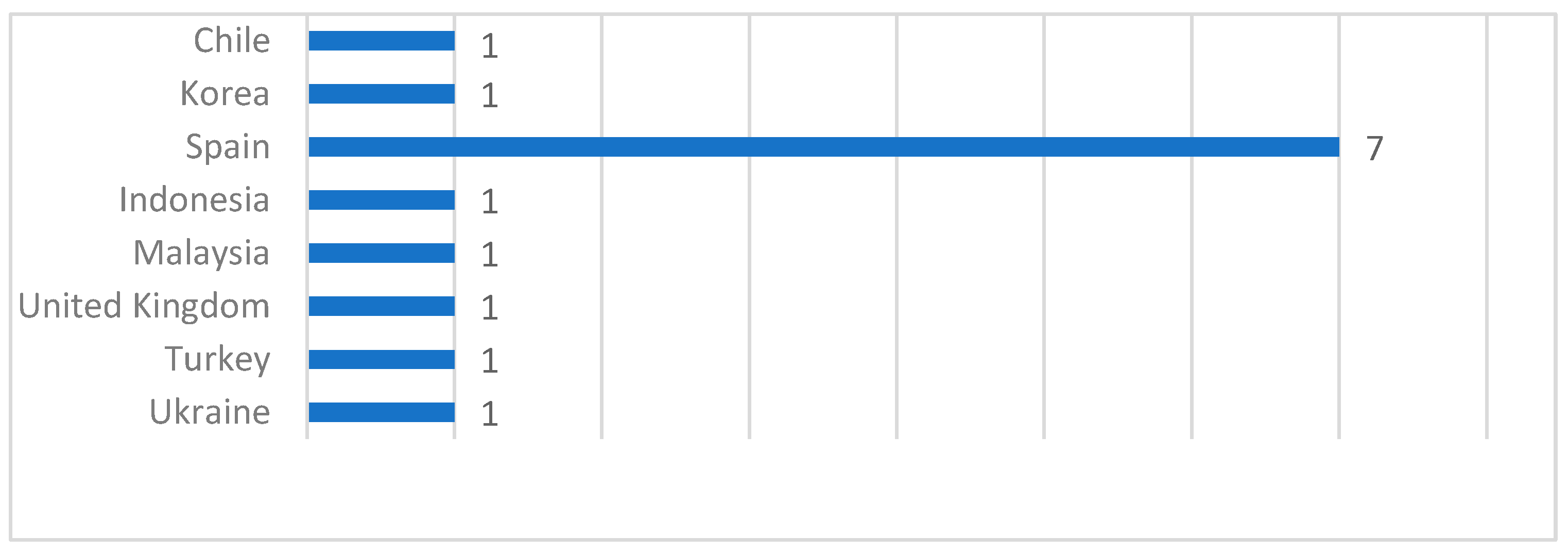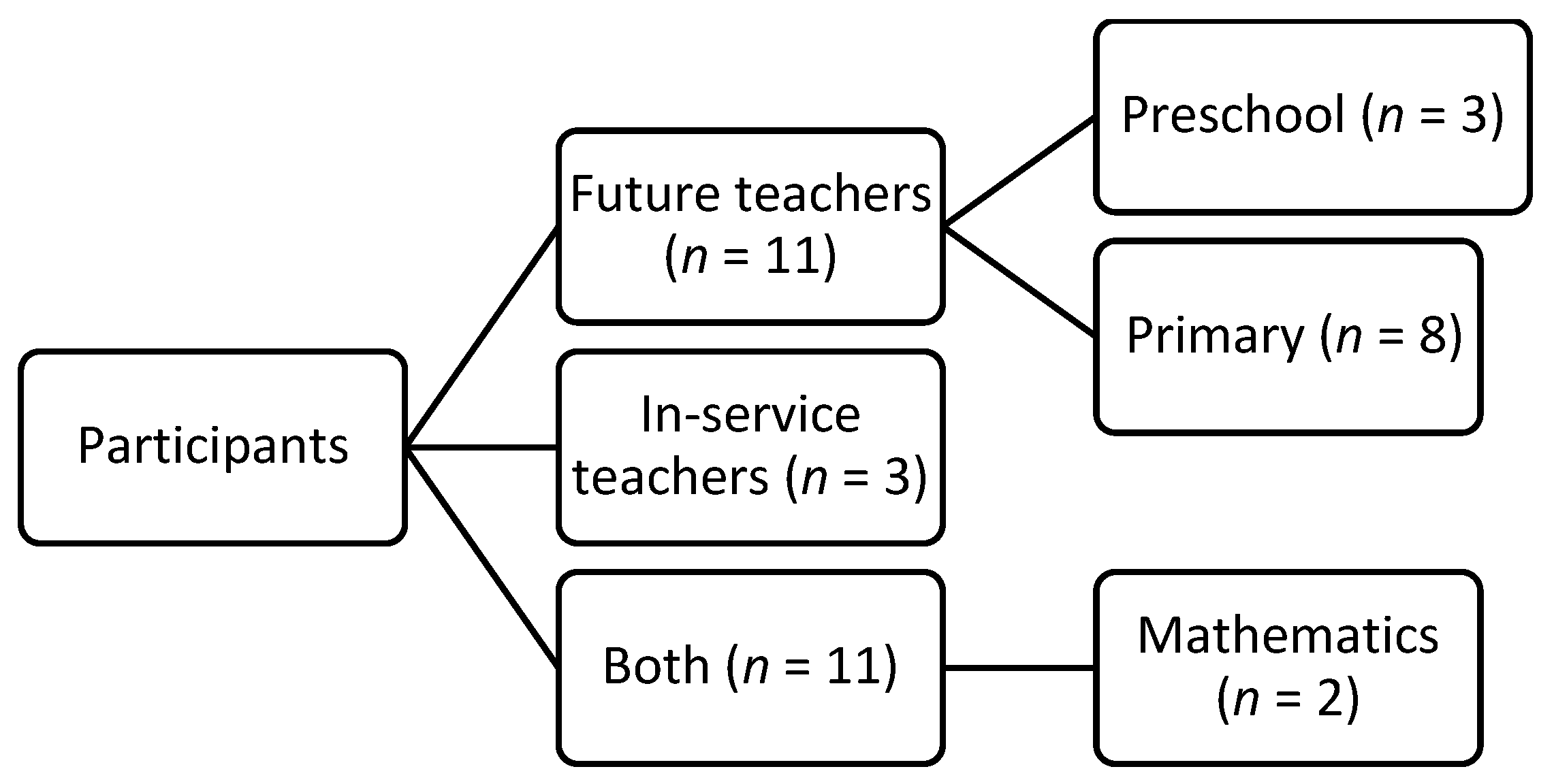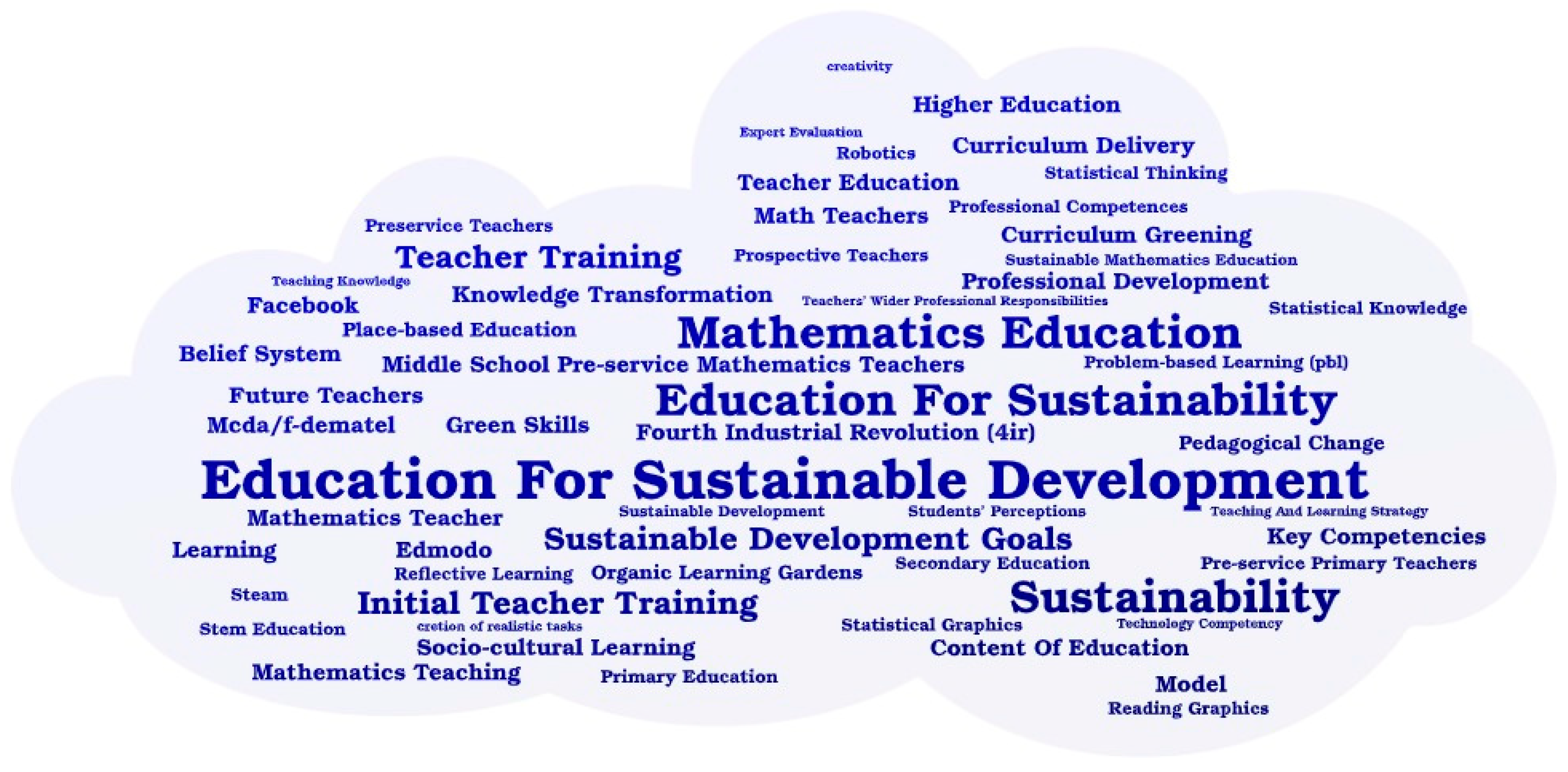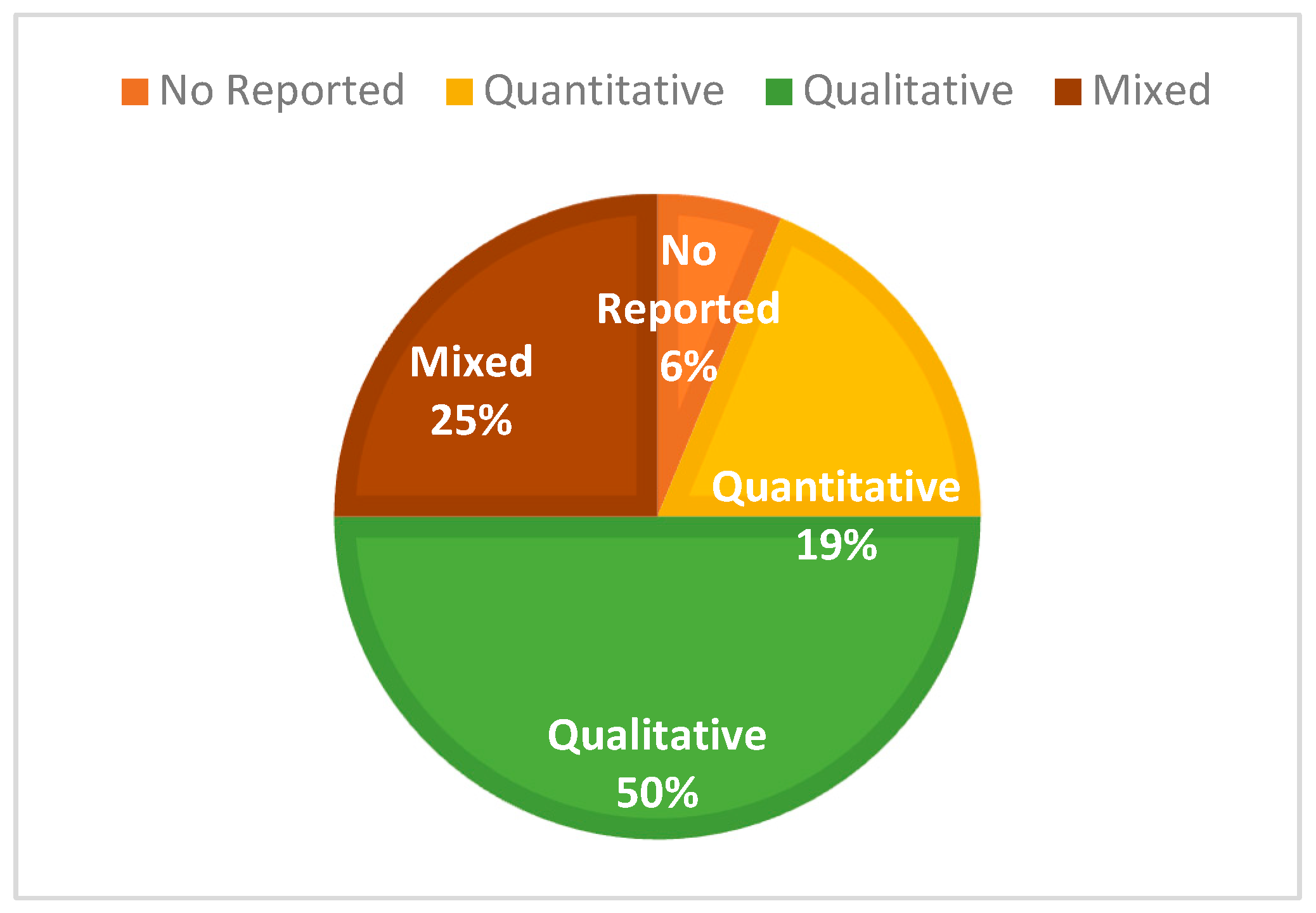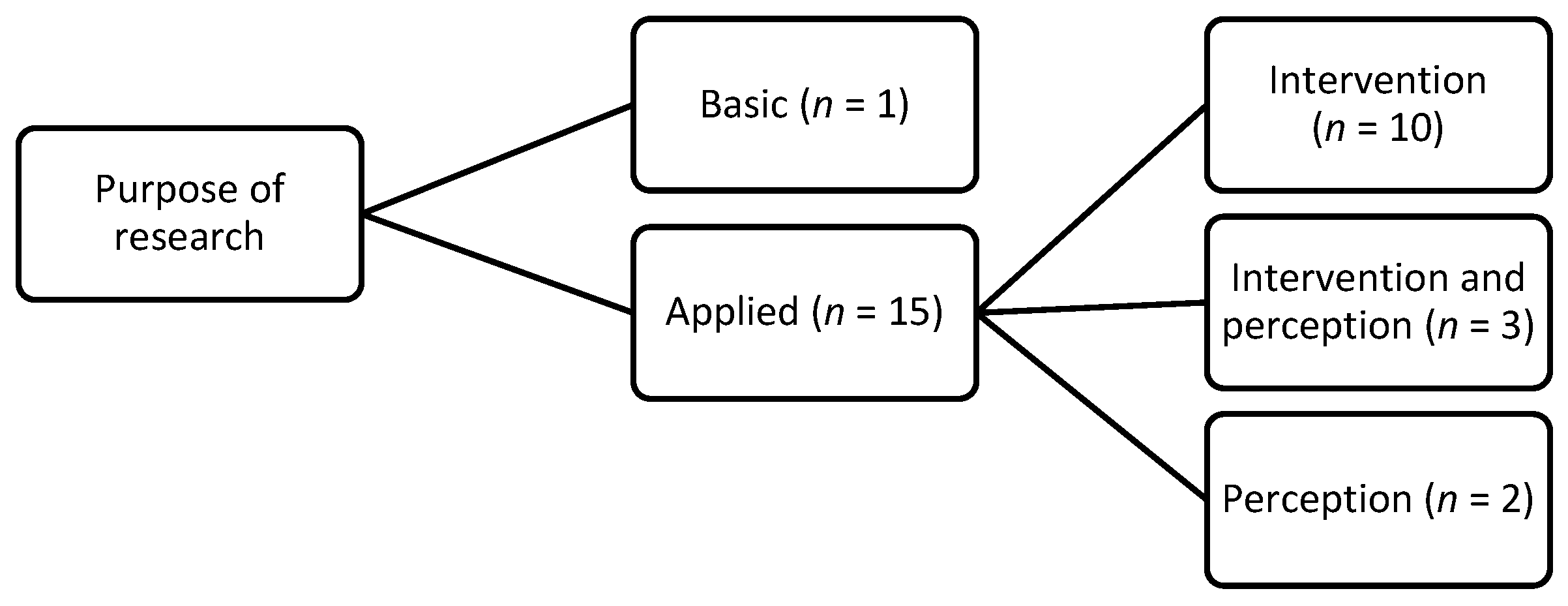1. Introduction
Beginning in the 1960s, numerous international organizations have voiced their concerns about the environment and proposed various mitigation strategies to tackle the challenges arising from rapid urbanization and industrialization. These strategies consider multiple perspectives, including political, social, cultural, and economic aspects [
1]. Among the most significant measures is the Brundtland Report, which introduced the concept of sustainability for the first time [
2,
3]. Sustainability refers to a form of development that takes into account social, economic, and environmental dimensions while preserving resources for future generations [
4].
The integration of ESD in teacher training and education has been promoted by various historical events and global initiatives. Among them, the Brundtland Report published in 1987 introduced the concept of sustainable development and highlighted the need to educate future generations on sustainability. Subsequently, the Earth Summit in Rio de Janeiro in 1992 emphasized the relevance of education in achieving sustainable development and presented “Agenda 21”, including a specific chapter on promoting education and training for sustainability [
5].
Following this, the United Nations (UN) member states have signed numerous agreements to promote sustainability through education (
Figure 1). In 2002, the United Nations Decade of Education for Sustainable Development (ESD) (UNDESD) was proclaimed for the period from 2005 to 2014. This initiative aimed to address sustainability by integrating ESD into curricula and teacher training programs [
6]. More recently, in 2015, the UN’s Sustainable Development Goals (SDGs) incorporated Goal 4.7, which promotes ESD in teacher training and education; within Goal 4 focused on ensuring quality education for all.
The inclusion of ESD in Target 4.7 of Sustainable Development Goal 4 highlights the importance of quality education in addressing sustainable development challenges. According to [
7], Target 4.7 states that UN member states must “ensure that all learners acquire the knowledge and skills needed to promote sustainable development, including through ESD.” Quality education that includes ESD can be a significant factor in achieving the remaining 16 SDGs, which address sustainability from social, economic, and environmental perspectives.
ESD goes beyond the transmission of knowledge. According to [
7], ESD involves incorporating its four dimensions into the education system (
Table 1) to promote not only individual autonomy but also the acquisition of inter- and transdisciplinary knowledge, competencies, and reflections that enable social transformation from within oneself. In this regard, it is crucial to examine how education, particularly mathematics education, can contribute to strengthening competencies associated with the survival and prosperity of humanity through teaching and learning.
It is important to note that, by incorporating ESD into the teaching of mathematics, mathematics teachers face multiple challenges in implementing ESD. One of the most notable challenges is the lack of training and resources to address sustainability in the classroom. Another significant challenge is the incorporation of ESD into the mathematics curriculum as it requires the adaptation of current content and pedagogical approaches. In addition, the implementation of ESD in the teaching of mathematics may require a mindset shift on the part of teachers so that they perceive sustainability as an essential element of mathematics education rather than an additional or separate topic. This may require deep reflection and commitment to effectively integrate sustainability into their teaching [
7,
8,
9,
10].
Both teacher training institutions and practicing teachers face the challenge of preparing their students to address sustainability challenges responsibly, reflectively, and actively. To achieve this, it is essential that teachers have a clear understanding of the knowledge, values, and perspectives of Education for Sustainable Development (ESD). They must also be able to address sustainability issues and develop ESD skills [
11,
12] in order to integrate the essential components of ESD into their teaching, as presented in
Table 2.
According to [
1], the effective integration of ESD into mathematics education can improve students’ problem solving and decision making skills, as well as their understanding of the interconnections between natural and social systems. These essential components of ESD include knowledge, skills, perspective, values, and problems related to sustainable development, encompassing aspects such as basic knowledge of natural sciences, social and human sciences, practical skills for sustainable living, understanding of global and local problems in a global context, teaching and analysis of values, and focus on the major social, economic, and environmental problems that threaten the sustainability of the planet.
By integrating these essential components of ESD into mathematics education, students will be better prepared to face current and future sustainability challenges, understanding how natural and social systems are interconnected and applying their problem solving and decision making skills in a global sustainability context.
1.1. Didactic–Mathematical Knowledge and Competencies (DMKC) Model and Model for Initial Teacher Training in Mathematics for Sustainability
Mathematics is fundamental for the development of critical thinking in citizens, enabling them to analyze, reason, and communicate mathematical concepts, structures, and ideas [
13]. This directly influences the future of civilization [
14]. In addition, the inclusion of probability and statistics in mandatory education can provide a broad understanding of other curriculum areas [
8]. This inclusion is especially suitable for linking with ESD as it facilitates mathematical literacy from different curricular dimensions [
14]. Moreover, mathematics is essential for organizing physical, social, and mental phenomena [
15], as well as a fundamental tool for solving mathematical problems in the world that surrounds each individual [
16].
In order to promote the education of individuals capable of generating positive changes in society through mathematics education, Alsina and Calabuig proposed a model for the initial training of mathematics teachers focused on sustainability [
17], which is presented in
Table 3.
This model aims to integrate the teaching of mathematics with a sustainability perspective, allowing educators to develop skills and competencies in their students to address mathematical problems linked to sustainable development in different contexts. The key aspects of the proposed model encompass connection with the environment, didactic–disciplinary knowledge, reflective and critical thinking, the learning needs of children, and the incorporation of sustainability into the curriculum.
Through training considering these components, future teachers would have the ability to professionally observe the natural, social, and cultural environment, determine what is relevant, and transfer it to teaching situations, evaluating its impact on social responsibility and commitment. In addition, they would possess a solid mastery of mathematical content and processes, as well as didactic skills to teach them properly and promote lifelong learning for their constant professional development. They would also be able to promote reflective and critical thinking in their students and acquire strategies for them to understand the relationship between the environment and mathematics.
It is essential to highlight that, for the implementation of this model, it is crucial to ensure that the teacher training curriculum focuses on sustainable development. This will help future teachers to select curricular knowledge with sustainability criteria and face the complexity of the constantly evolving world [
18]. In this way, future teachers could make use of the knowledge acquired in their curriculum training with sustainability criteria to adapt their mathematics teaching, integrating the problems of the complexity of the constantly evolving world. Thus, mathematics education could favor the training of social and cultural change agents committed to sustainability and the future of society [
19].
In order to provide quality mathematics education, it is essential for teachers to have solid knowledge in both the subject and its didactics, allowing them to promote fundamental mathematical skills in students, including reasoning, analysis, and communication. These skills are crucial for facing real-world situations and promoting sustainable development [
13,
20].
In this context, the DMKC model, based on the onto-semiotic approach proposed by Godino et al. [
21], is presented as a valuable tool to support these initiatives and train teachers with appropriate disciplinary and didactic knowledge to improve the teaching of mathematics in relation to real-life situations. From the epistemic facet, the DMKC model provides appropriate disciplinary–didactic knowledge for teaching mathematics in relation to real-life situations. In terms of the cognitive facet, the DMKC model allows for broader development of epistemological and cognitive knowledge, enabling students to interact in class with interest and perseverance, mastering the correct use of mathematical norms to solve real problems associated with the 17 SDGs.
The model is composed of six facets, as shown in
Table 4. From the affective facet, the DMKC model addresses the teaching and learning of mathematics from an anthropological and onto-semiotic perspective, allowing for the integration of sustainability in mathematics education through a comprehensive approach that considers the affective, emotional, attitudinal, and belief aspects of students in relation to mathematical objects and the process of study.
Regarding the interactional facet, the DMKC model provides knowledge on how to teach mathematics, how to organize tasks, how to solve student difficulties, and how to establish effective interactions in the classroom. Finally, from the mediational facet, the DMKC model considers the appropriate use of technological, material, and temporal resources to enhance student learning, while, from the ecological facet, the DMKC model allows for establishing links between the teaching of mathematics and other disciplines, as well as considering the curricular, socioprofessional, political, and economic factors that condition the processes of teaching mathematics. Teachers trained in the facets of the DMKC model can contribute to sustainable development in mathematics classes within the framework of ESD.
1.2. Developing Sustainability Transversal Competencies for Higher Education Professionals
With the aim of properly preparing new generations to acquire basic competencies in sustainability and make informed decisions in their personal and professional lives, in 2002 [
22], the Sectorial Commission of the Conference of Rectors of Spanish Universities (CRUE) created a group to redesign curricular activities and promote sustainable development. In 2005, the document “Guidelines for the Introduction of Sustainability into the Curriculum” was approved in order to incorporate the four transversal competencies for sustainability (
Table 5) into the training of university professionals.
These competencies are defined as a “complex and integrated set of knowledge, skills, abilities, attitudes and values that allow for the operation and transformation of reality with sustainability criteria” [
22] (p. 1). They involve the critical understanding of social and economic problems (SOS1), making informed decisions (SOS2), taking action, and constructing a personal ethics in line with sustainability values (SOS4). They also include the competency to participate in community processes that promote sustainability (SOS3). These competencies must be taught from cognitive, methodological, and attitudinal domains to incorporate sustainability into the training of university professionals and to form teachers capable of guiding primary and mathematics education towards sustainability. By integrating these sustainability competencies into the training of university professionals, it contributes to the promotion of sustainable development in various fields, including mathematics education.
The UNESCO 2030 Agenda highlights the importance of incorporating sustainability into mathematics education at all levels [
7]. Therefore, it is crucial to examine the progress of this topic among both in-service and pre-service teachers as they play a key role in promoting sustainable development in their students [
3,
11,
23,
24].
To evaluate the current situation in this area, a systematic review was carried out to analyze scientific production related to Education for Sustainable Development (ESD) for in-service and pre-service teachers who teach mathematics. The review was conducted following the guidelines established by the Preferred Reporting Items for Systematic Reviews and Meta-Analyses (PRISMA) statement to efficiently address this specific topic [
25]. The general objective of the review was to analyze the current state of scientific production related to the integration of ESD in the teaching of mathematics by in-service and pre-service teachers.
The specific objectives (SO) of this review were:
- SO 1.
To examine scientific production in this field according to bibliometric indicators.
- SO 2.
To classify scientific production in this area of study based on methodological aspects.
- SO 3.
To analyze the sustainability elements and didactic competencies employed for the integration of education for sustainable development in the teaching of mathematics by pre-service and in-service teachers.
Although there are some systematic reviews on sustainable development in education in general [
26], there is a lack of specific reviews on the topic in mathematics teachers, both in-service and pre-service. This systematic review aims to fill that gap in the scientific literature, providing a holistic and updated view [
25] on the relationship between sustainable development in education and the training of in-service and pre-service mathematics teachers. It is hoped that this work will contribute to the advancement of knowledge in this field of study.
3. Results
In this section, the results obtained from the analysis of the units of analysis are presented in three sections: (1) indicators involved in scientific production; (2) predominant research methodologies and instruments; and (3) pedagogical approaches, dimensions, components, and competencies of ESD and didactic–mathematical competencies.
3.1. Indicators Involved in Scientific Production
To fulfill the established objective SO 1, this section presents the results of the analysis of the selected articles using bibliometric analysis, which enables the collection of essential data to identify the selected articles, including the publishing journal, year of publication, authorship, keywords, citations, among others.
3.1.1. Journals
Table 10 presents the journals where the 16 selected articles were published. It can be observed that the journal “Sustainability” has the highest number of articles in this area as it focuses on compiling interdisciplinary studies related to sustainability and sustainable development in the environmental, cultural, economic, and social dimensions of human beings. Furthermore, it is noteworthy that the majority of the articles were written in English (75%) as this language is typically predominant in mainstream journals.
3.1.2. Publication Years of the Articles
During the search for articles in the databases, no restrictions were placed on the time period. However, as shown in
Figure 3, the number of publications is scarce in the early years, with 2015 being the year of the first publication found, indicating that the subject of study is an emerging area in research. In the following years, a gradual increase in the number of publications is observed, reaching a peak of eight in 2020. However, it should be noted that this figure is still low compared to other research topics. These results suggest that the topic under study is an emerging issue and of growing interest to researchers in the field. The increase in the number of publications in recent years could reflect greater concern for the topic in the scientific community, which in turn could generate new research questions and motivate future studies in this area. Consequently, these findings highlight the need to continue exploring the topic and promote additional research that allows for a deeper understanding of it.
3.1.3. Country of Affiliation of the First Author
Figure 4 shows the geographical distribution of publications related to sustainable development by the country of affiliation of the first author. The results indicate that the majority of the analyzed studies come from European countries, with a total of 10 publications. This suggests that there is a concentration of research on sustainable development in Europe (A.1, A.2, A.7, A.8, A.9, A.10, A.11, A.13, A.15, A.16), three to Asia (A.3, A.5, A.14). On the other hand, only three studies were led by authors from Asia and another three led by authors from America (A.4, A.6, A.12).
It is possible to observe that the majority of the research on sustainable development is led by Spanish authors, accounting for a total of seven publications, which suggests a significant presence of Spain in the field of research on this subject. On the other hand, there is an unequal geographical distribution regarding research in this field, indicating the need to promote greater collaboration between researchers from different countries and continents. Additionally, it is important to highlight that countries such as Chile and others have also stood out for their participation in the study of sustainable development, reflecting a global interest in addressing this critical issue.
3.1.4. Participants
Regarding the sample or participants of the analyzed studies (
Figure 5), a total of 15 articles involving teachers were counted. Among them, 11 focus on future teachers (A.2, A.4, A.5, A.6, A.8, A.9, A.10, A.11, A.12, A.13, A.15), where, in A.8 and A.15, future preschool and primary teachers participated. In contrast, only three studies involve active teachers (A.1, A.7, A.14), and only one study includes both groups (A.3). This finding suggests that there is greater emphasis on the training of pre-service teachers than on in-service teachers in the area of sustainable development. Therefore, it is essential to involve in-service teachers in research as their experience and practical knowledge are crucial for addressing current education challenges. Additionally, researching in-service teachers can contribute to professional development and improvement in education quality.
3.1.5. Key Words
For the analysis of this category of keywords declared by the authors in the articles, a total of 75 keywords were recorded from the selected articles. In order to obtain a general visualization, they were entered into the WordArt program (web version) to generate the cloud shown in
Figure 6. In this figure, the most frequently appearing words are “Education for Sustainable Development” (
n = 6), “Education for sustainability” (
n = 4), “sustainability” (
n = 4), and “mathematics education” (
n = 4). Additionally, it is also possible to identify the fields that have been more and less explored within this topic. The results obtained suggest that the main focus of the analyzed documents centers on ESD, both in relation to the terminology used and the volume of articles focused on this subject. The presence of “mathematics education” in the word cloud also indicates that this field is an area of interest in the context of sustainable development. Identifying the most and least researched areas in relation to this topic could have significant implications for future inquiries in this field.
3.1.6. Citation in Google Scholar
Table 11 shows the number of citations in Google Scholar for the analyzed articles. It is important to highlight article A.2, which refers to a model based on reflective learning for the training of mathematics teachers in sustainability and has the highest number of citations (
n = 24). This demonstrates the need for a model with a reflective learning approach to address this topic and adequately train teachers.
Additionally, two groups of articles with relatively high citations can be observed. The first group includes A.3, A.8, and A.9, which emphasize the importance of technology as a resource for incorporating sustainability in mathematics education. On the other hand, the second group contains only article A.1, which highlights the need for an instrument that improves teaching practice by incorporating the concept of sustainability.
3.2. Declared Research Methodology and Instruments
In this section, the results of the analysis of the selected articles corresponding to SO 2 are presented. This analysis includes information about the methodologies, the type of study, and the instruments used.
3.2.1. Methodology
In the present study on the incorporation of sustainability in mathematics education, we considered only the methodology declared by the authors of the analyzed articles, with the aim of ensuring the reliability of the obtained results.
Figure 7 shows the declared methodology in the analyzed articles. It is observed that the qualitative methodology is the most widely used in research on this topic, present in most of the analyzed articles (A.1, A.2, A.3, A.4, A.6, A.10, A.11, A.12). On the other hand, the use of mixed methodology is evidenced in four articles (A.5, A.7, A.13, A.15), while the quantitative methodology is employed in three cases (A.8, A.9, A.14). Regarding article A.16, the research methodology used is not declared. It is worth noting that, although A.5 and A.7 declare the use of a mixed methodology, they mainly focus on qualitative analysis due to their objective of delving into the subject matter.
3.2.2. Type of Study
According to the research methodology presented in
Figure 8, investigations can be classified into two main categories, namely basic and applied research. Basic research aims to generate new knowledge and serves as the foundation for applied research. On the other hand, applied research seeks to test theory and provide solutions to real-world problems [
42]. Our analysis of the 16 articles indicates that 15 of them are aligned with applied research, with a predominant focus on intervention studies. Specifically, the majority of the studies implemented activities based on the integration of ESD and mathematics, targeting a particular problem or objective. Three studies combined interventions with perception analysis, examining participants’ attitudes and beliefs towards the integration of ESD and mathematics. Finally, two studies concentrated on perception analysis alone, evaluating participants’ attitudes and beliefs towards ESD and mathematics integration. Hence, the investigation primarily focuses on implementing ESD and mathematics-based interventions to address specific problems or achieve predetermined goals.
3.2.3. Instrument for Obtaining Information
In this section, we analyze the instruments used by the authors. As shown in
Figure 9, the studies primarily utilized questionnaires (A.3, A.5, A.6, A.7, A.8, A.10, A.13, A.4), analysis categories (A.1, A.2, A.3, A.4, A.5, A.7, A.9, A.11), and assessment rubrics (A.15) as data collection instruments. Some studies employed more than one instrument, such as A.3, A.5, and A.7. It is important to note that these results align with the findings presented in
Section 3.2.2 as the use of questionnaires allows for diagnosing certain aspects of the educational system or learning processes, while categorizing information into basic conceptual units through analysis categories is a technique commonly used in educational research [
30]. It is important to mention that the lack of instrument declaration in two studies could be considered a limitation in the analysis as the lack of transparency in the selection and use of instruments could affect the validity and reliability of the obtained results.
3.3. Sustainability Elements and Teaching Staff
In order to analyze this section, content analysis was employed. This entailed the utilization of predetermined categories, which included the definition of the ESD dimension (as seen in
Table 1), ESD component (as seen in
Table 2), didactic suitability facets of the DMKC model (as seen in
Table 3), the model for teacher training that teaches mathematics (as seen in
Table 4), and sustainability competencies (as seen in
Table 5). These categories were systematically utilized to categorize and analyze the data derived from the selected articles.
3.3.1. SDG Addressed
To ensure the reliability of the results in the analysis of this category, we have only considered the SDGs declared by the authors in the articles. It was found that only three studies explicitly mention an SDG, specifically A.6, A.13, and A.14. Article A.13 addresses SDGs 3 (Good Health and Well-being), 11 (Sustainable Cities and Communities), and 13 (Climate Action), while article A.6 refers to SDG 4 (Quality Education). This suggests that, although some studies deal with the relationship between mathematics education and the SDGs, the majority of the reviewed papers do not explicitly emphasize this link. Therefore, it is essential to pay more attention to the relationship between mathematics education and the SDGs, as well as to promote their integration to raise awareness and action around global sustainability challenges in teaching mathematics.
3.3.2. ESD Dimension
According to
Figure 10, most of the analyzed articles address ESD from the dimensions of pedagogy, learning environment, and learning content, present in all the selected studies. In fact, thirteen of the articles specifically address the learning content dimension. These findings suggest a significant recognition of the relationship between mathematics teaching and the environment, as well as the need to incorporate sustainability into learning content. As a result, essential skills are promoted, such as critical and systemic thinking, collaborative decision making, and responsibility towards present and future generations. However,
Figure 10 also shows that only three of the analyzed articles address ESD from the perspective of social transformation. These results highlight the importance of continuing to work on integrating ESD into mathematics teaching from multiple dimensions to achieve an effective impact on social transformation and sustainability.
3.3.3. ESD Components
Regarding the ESD components, it can be observed in
Figure 11 that knowledge (A.1, A.2, A.3, A.4, A.5, A.6, A.7, A.8, A.9, A.10, A.11, A.12, A.13, A.14, A.15, A.16) and skills (A.2, A.3, A.4, A.5, A.6, A.7, A.8, A.9, A.10, A.11, A.12, A.13, A.14, A.15, A.16) are the most frequent components in the reviewed articles. On the other hand, the remaining components, such as perspective (A.2, A.4, A.7, A.10, A.11, A.12, A.13, A.14, A.15), value (A.1, A.2, A.4, A.9, A.11, A.12, A.13, A.14, A.15), and problems (A.2, A.4, A.7, A.10, A.11, A.12, A.13, A.14, A.15), with a frequency of 9, rank third. These results suggest that, to incorporate ESD in the training and service of teachers who teach mathematics, it is important to possess knowledge regarding the sustainability dimension, skills focused on problem solving, and continuous practice for living sustainably. It is also necessary for mathematics education to integrate perspectives and values from ESD to help students understand problems in a global context.
Therefore, learning can be focused on problem solving with real data about unsustainable human activities [
26], such as the generation of medical waste during the COVID-19 pandemic (A.14) or air pollution (A.13), or in the design of didactic units (A.4, A.13, and A.11). In this way, participants could investigate the urgency of generating solutions to remedy these situations and take responsibility as change agents to educate the younger generation from mathematics education.
3.3.4. Pedagogical Considerations for ESD Training
Regarding pedagogical considerations for ESD training,
Figure 12 shows that the most addressed components in the selected articles are the connection to the environment, reflective and critical thinking, and didactic–disciplinary knowledge. The study’s findings emphasize the importance of teachers implementing ESD in mathematics teaching not only requiring solid mathematical content knowledge and pedagogical strategies but also a comprehensive understanding of the relationship between the environment and mathematics. In this way, they can incorporate social, cultural, and environmental aspects into the teaching process, thus promoting autonomous learning and empowering students to become agents of social and cultural change.
3.3.5. Didactic Competencies
In regard to didactic competencies,
Figure 13 shows that the selected articles primarily emphasize the ecological and mediational facets for incorporating ESD into the training and development of teachers teaching mathematics. This implies that emphasis is placed on the relationship between mathematical content and other disciplines, as well as on curricular and socioprofessional factors in teaching mathematics (A.1, A.2, A.4, A.5, A.6, A.7, A.11, A.12, A.13, A.14, A.15). Additionally, some articles (A.3, A.5, A.7, A.9, A.10, A.12, A.13, A.14, A.16) highlight the importance of using technology to enhance student learning. The results suggest that it is important to develop competencies in the ecological and mediational facets to integrate ESD into mathematics teaching. This means that teachers should understand the relationship between mathematics and other disciplines, consider curricular and socioprofessional factors in teaching mathematics, and use technology to improve student learning.
3.3.6. Sustainability Competence
Regarding sustainability competencies,
Figure 14 reveals that the most emphasized competencies are SOS 1 and SOS 4. This shows that, in the selected articles, it is considered essential for teachers to develop the ability to contextualize mathematical knowledge in relation to sustainable development problems and promote ethical principles and sustainability values in their teaching activities. This suggests that, in order to incorporate ESD in the training or professional development of teachers who teach mathematics, it is crucial to foster the development of these sustainability competencies. By contextualizing mathematical knowledge in relation to sustainable development problems, teachers can help their students to understand how mathematics can contribute to solving real and relevant issues. On the other hand, by promoting ethical principles and sustainability values in the teaching of mathematics, teachers can foster sustainability education and awareness in future generations.
4. Discussion and Conclusions
For over a decade, the incorporation of ESD in all educational disciplines has been internationally driven [
7]. Despite this, the results of SO 1 of this study reveal a limited number of research studies on ESD in the field of mathematics education, which hinders its large-scale implementation [
43].
In relation to SO 2, the analyzed articles mainly employ qualitative approaches, using interviews and open questionnaires to collect information from pre-service and in-service teachers who teach mathematics. Although some studies use mixed approaches, quantitative results complement qualitative ones, showing an interest in deepening the topic. It is important to mention that the methodology of studies whose authors have not explicitly declared their approach cannot be explored. Exploring without following the established criteria could affect the accuracy and reliability of our results. Therefore, in this study, only methodological approaches explicitly declared by the authors in the articles were considered.
Findings in relation to SO 3 indicate the following regarding the integration of sustainability in pre-service and in-service teachers who teach mathematics:
The connection between mathematics and ESD is established at cognitive and socio-emotional levels but has weaknesses in the behavioral aspect, necessary to promote participation and action in community activities.
The interdisciplinarity of mathematics allows its teaching in ESD from real and environment-related contexts.
The use of technology facilitates students’ understanding of the relationship between mathematics and the world and constitutes a strategy for their teaching in the context of ESD.
These findings provide insights into the current trend of integrating ESD into mathematics education through ESD elements and didactic competencies, as evidenced by recent studies involving both pre-service and practicing teachers. In our study, we cannot address all aspects of ESD, models, and theories comprehensively and definitively as we are limited by the information available in the articles we have reviewed. Furthermore, as noted, the field of ESD in mathematics teaching is emerging, and a universally accepted model or theory has not yet been established.
The integration of ESD in mathematics teaching is essential for cultivating global awareness in future generations about the challenges our planet faces [
1,
2]. Pre-service and in-service teachers who teach mathematics have a crucial role in promoting sustainability in their classrooms, and it is essential that they receive adequate training and education to teach mathematics consciously and related to sustainability [
3].
To achieve this goal, it is necessary for these teachers to adopt a broad curricular approach that specifically addresses issues related to sustainability in mathematics teaching [
7,
41], and to have the necessary competencies to integrate ESD into their teaching [
4,
6,
7,
11].
The DKMC and sustainability teacher training models provide specific ESD elements for the continuous training and education of mathematics teachers. These models support both the mastery of didactic knowledge and mathematical content, as well as the development of competencies related to teaching and sustainability. The inclusion of these models in the practice of pre-service and in-service teachers can be beneficial for improving teacher performance and student learning [
10,
20,
21].
It is essential to include sustainability-related content and competencies in the curriculum, as well as to adapt the planning and evaluation of mathematics subjects to address ESD issues in a transversal manner. This involves the incorporation of objectives, contents, and evaluation criteria that specifically address aspects of sustainability in the field of mathematics education [
7,
17,
20,
21,
23].
On the other hand, it is also important to adopt innovative pedagogical approaches, such as problem-based learning, cooperative learning, and the use of digital technologies and educational robotics, as this can facilitate the development of sustainability-related competencies in the continuous training and education of mathematics teachers [
34,
36,
39].
It should be noted that this study presents both limitations and projections. Regarding the limitations, it should be mentioned that the review was based on a selection of databases, which could have excluded related studies from other sources. Furthermore, although 16 articles were analyzed in detail, it is possible that others were published after the selection and analysis process of this study and could be of interest to this report. Likewise, it is necessary to consider that, due to the lack of specific studies, the results obtained do not allow generalizing the progress of ESD in teacher education, and the information provided is limited in terms of the relationship between mathematics teaching and the SDGs [
35,
41].
Regarding the projection, the importance of implementing ESD teacher training and education, developing new strategies and didactic resources, and integrating technologies in mathematics teaching, especially in relation to the 17 SDGs, are highlighted. The consideration of these factors is crucial for advancing the integration of ESD in mathematics teaching and promoting sustainable development in the educational field.
In conclusion, the incorporation of ESD in mathematics teaching has experienced limited progress in recent times, which hinders its large-scale application in the educational context. Despite the limitations observed in this study, important perspectives for optimizing the inclusion of ESD in mathematics education are highlighted, and it is essential to continue exploring and creating new tactics to advance the insertion of ESD in mathematics instruction on a large scale in the school environment. Progress in this area requires a collective and continuous effort from teachers, educational institutions, policymakers, and researchers in the field of mathematics education and sustainability [
7,
23,
32,
37,
41,
44,
45].
